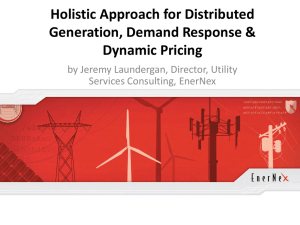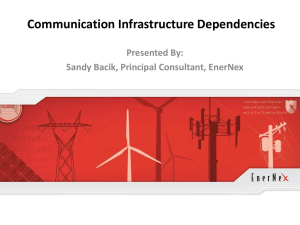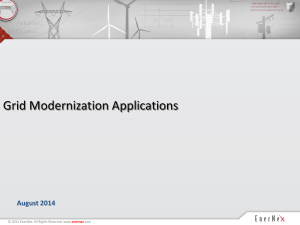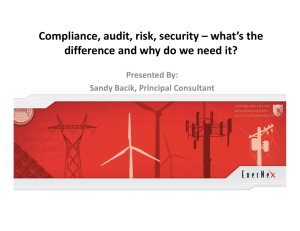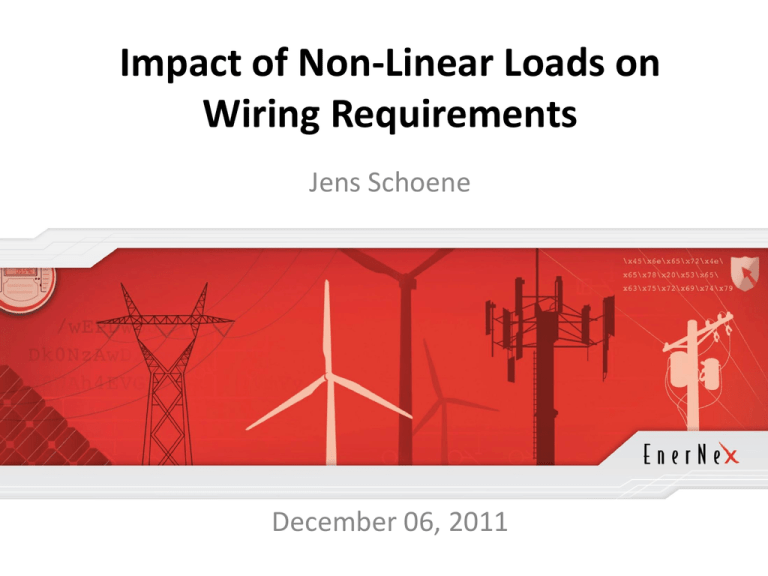
Impact of Non-Linear Loads on
Wiring Requirements
Jens Schoene
December 06, 2011
© 2011 EnerNex. All Rights Reserved. www.enernex.com
Who we are
EnerNex is a consulting company with headquarter in Knoxville, TN
Power System Studies
–
–
–
–
Power Quality
Wind and Solar (design, generator modeling,…)
T&D (bulk system analysis, SSR, CSS)
Safety (arc flash, grounding, electromagnetic coupling)
Smart Grid Engineering Studies
– Advanced Metering Infrastructure (AMI)
– Utility Communication Architecture
– Security
© 2011 EnerNex. All Rights Reserved. www.enernex.com
2
Outline
Motivation
Fundamentals of Power Quality
Changing Energy Consumption and Changing Loads
Characteristics of “New” Lighting Technologies
Case Studies
Conclusions and Recommendations
© 2011 EnerNex. All Rights Reserved. www.enernex.com
3
Motivation
© 2011 EnerNex. All Rights Reserved. www.enernex.com
Background
Higher penetration of “new” load types:
–
–
–
–
Energy-efficient lighting
Consumer electronics
Residential appliances
Plug-in Electric Vehicles
What is the impact?
– Wiring requirements
– Efficiency, reliability, power quality
© 2011 EnerNex. All Rights Reserved. www.enernex.com
NEC Wiring Requirement
NEC 310.15(B)(5)(c)
No information regarding harmonic limits for which the
neutral has to be considered a current carrying conductor
No information regarding required size of neutral
conductor in the presence of harmonics
Old buildings have undersized neutral or neutral size equals
the size of the phase conductor.
New commercial buildings commonly employ oversized
neutral.
© 2011 EnerNex. All Rights Reserved. www.enernex.com
6
Fundamentals of
Power Quality
© 2011 EnerNex. All Rights Reserved. www.enernex.com
What are Harmonics?
Harmonics are sinusoidal voltages
and currents with frequencies that
are integer multiples of the
fundamental frequency (60 Hz in the
United States).
Value of the multiplier corresponds
to the harmonic order.
© 2011 EnerNex. All Rights Reserved. www.enernex.com
General Effects of Harmonics
Harmonics can cause
Transformer overheating resulting in the shortening of the
expected lifetime
Capacitor can failure due to excessive harmonic currents or
overvoltage stress on dielectrics
Increased ohmic losses and shortened lifetime of cables
Overloaded neutral conductors (odd harmonic currents do
not cancel in the neutral conductor)
Nuisance tripping of breakers and fuses
Motor heating
Control misoperation
Communication system interference
Degrade meter accuracy
© 2011 EnerNex. All Rights Reserved. www.enernex.com
Effects on Wiring Requirements
Measure of heating in conductor is product of squared
current I and impedance Z (I2Z)
Harmonics increase heating in conductors due to
– additional load current flowing throughconductor
– current redistribution inside conductor (skin effect)
© 2011 EnerNex. All Rights Reserved. www.enernex.com
10
What is special about 3rd Harmonics?
Add arithmetically in the Neutral
(assuming balanced 3-phase system)
Many electronic loads produce them.
Neutral size in commercial building of
particular concern.
© 2011 EnerNex. All Rights Reserved. www.enernex.com
How to Quantify Harmonics
Individual Harmonic Distortion (IHD) Level
Percentage of individual harmonic relative to
fundamental
Total Harmonic Distortion (THD) Level
Percentage of RMS of all harmonics relative 𝑇𝐻𝐷 =
to fundamental
IEEE 519 specifies limits
IHD for Odd Harmonic Currents
ISC/IL
h < 11
11 ≤ h < 17
17 ≤ h < 23
23 ≤ h < 35
35 ≤ h
<20
20-50
50-100
100-1000
>1000
4.0%
7.0%
10.0%
12.0%
15.0%
2.0%
3.5%
4.5%
5.5%
7.0%
1.5%
2.5%
4.0%
5.0%
6.0%
0.6%
1.0%
1.5%
2.0%
2.5%
0.3%
0.5%
0.7%
1.0%
1.4%
© 2011 EnerNex. All Rights Reserved. www.enernex.com
2
𝑛
𝑖=2 𝐻𝑖
𝐻1
∙ 100%
THD for
Odd
Harmonic
Currents
5.0%
8.0%
12.0%
15.0%
20.0%
12
Changing Energy Consumption
and
Changing Loads
© 2011 EnerNex. All Rights Reserved. www.enernex.com
Increasing Electricity Consumption
Residential Electricity Consumption in the U.S.A. 1990-2006
5000
4500
1400
4000
1200
3500
1000
Per-Capita
Electricity
Consumption
800
600
400
Total
Electricity
Consumption
2500
2000
1500
1000
200
500
0
1990
3000
0
1992
1994
1996
1998
Year
© 2011 EnerNex. All Rights Reserved. www.enernex.com
2000
2002
2004
2006
Per-Capita Electricity Consumption (kWh)
Total Electricity Consumption (TWh)
1600
source:
International
Energy Agency,
2009
14
What consumes Electricity?
Distribution of USA Electricity Consumption in 2005
source:
Energy
Information
Administration,
2008
© 2011 EnerNex. All Rights Reserved. www.enernex.com
15
Changing Electricity Consumption
Change in Electricity Consumption (TWh)
Changes in Electricity Consumption in the USA from 1998 to 2008
120.00
100.00
80.00
60.00
40.00
20.00
0.00
-20.00
-40.00
-60.00
© 2011 EnerNex. All Rights Reserved. www.enernex.com
source:
International
Energy Agency,
2009
16
Changing Electricity Consumption
Global CE and ICT Electricity Consumption 1990-2030 (Business As Usual)
Electricity Consumption (TWh)
2000
1800
1600
Miscellaneous
1400
PCs and Monitors
1200
Set-top Boxes
Televisions
1000
800
600
400
200
0
1990
1995
2000
2005
2010
2015
2020
2025
2030
source:
International
Energy Agency,
2009
Year
© 2011 EnerNex. All Rights Reserved. www.enernex.com
17
Changing Electricity Consumption
Global CE and ICT Electricity Consumption 1990-2030 (BAU, LLCC, BAT)
Electricity Consumption (TWh)
2000
1800
1600
1400
Business As Usual (BAU)
Least Life-Cycle Cost (LLCC)
Best Available Technology (BAT)
1200
1000
800
600
400
200
0
1990
1995
2000
2005
2010
Year
© 2011 EnerNex. All Rights Reserved. www.enernex.com
2015
2020
2025
2030
source:
International
Energy Agency,
2009
18
Lighting
Lighting is 16% of residential load
Most incandescent lamps phased-out by 2014
Compact Fluorescent Lamps
– Color Rendering Index around 80
– Some are dimmable (most are not)
– Some are high power factor / low harmonics (most are not)
White LED
– Even more efficient than CFL
© 2011 EnerNex. All Rights Reserved. www.enernex.com
19
Characteristics of
“New” Lighting Technologies
© 2011 EnerNex. All Rights Reserved. www.enernex.com
Increased Energy Efficiency
250
Electricity Consumption (Watt)
Incandescent Light (750 to 4,000 Hours)
Compact-Fluorescent Light (8,000 to 12,000 Hours)
200
White LED (30,000 to 50,000 Hours)
150
100
50
0
0
500
1000
1500
2000
2500
3000
3500
4000
4500
Initial Luminous Flux (Lumen)
© 2011 EnerNex. All Rights Reserved. www.enernex.com
21
How does a CFL work?
Electronic Ballast in Energy-Efficient Lighting
© 2011 EnerNex. All Rights Reserved. www.enernex.com
22
Harmonic Characteristics
Incandescent
Compact
Fluorescent
White LED
© 2011 EnerNex. All Rights Reserved. www.enernex.com
23
Case Studies
© 2011 EnerNex. All Rights Reserved. www.enernex.com
Currents and Voltages Measured at
Different Locations (PQube Data)
Comp. 1: Office Building in Knoxville, TN
Transformer Configuration
Nominal Line-to-Neutral Voltage
Nominal Line-to-Line Voltage
Nominal Frequency
Wye/Star
120V
208V
60Hz
Comp. 2: Manufacturing Facility in Alameda, CA
Transformer Configuration
Nominal Line-to-Neutral Voltage
Nominal Line-to-Line Voltage
Nominal Frequency
Wye/Star
277V
480V
60Hz
Comp. 3: Office Building in Santa Clara, CA
Power Configuration
Nominal Line-to-Neutral Voltage
Nominal Line-to-Line Voltage
Nominal Frequency
Wye/Star
120V
208V
60Hz
Comp. 4 Manufacturing Facility in Karlsruhe, Germany
Power Configuration
Nominal Line-to-Neutral Voltage
Nominal Line-to-Line Voltage
Nominal Frequency
© 2011 EnerNex. All Rights Reserved. www.enernex.com
Wye/Star
230V
400V
50Hz
25
Phase Currents
Industrial
Commercial
Industrial
© 2011 EnerNex. All Rights Reserved. www.enernex.com
Industrial
Commercial
26
Neutral Currents
Commercial
Industrial
© 2011 EnerNex. All Rights Reserved. www.enernex.com
Industrial
Commercial
27
Conclusion and
Recommendations
© 2011 EnerNex. All Rights Reserved. www.enernex.com
Conclusions & Recommendations
Electricity consumption and load characteristics changing
3rd harmonics produced by power electronics are concern
NEC does recognize neutral as current carrying conductor,
but no guidance/requirement regarding size.
Neutral sizing requirements should be based on statistically
significant data from measurements of neutral currents in
different environments (office buildings, residential
building, etc.)
© 2011 EnerNex. All Rights Reserved. www.enernex.com
29
Backup
© 2011 EnerNex. All Rights Reserved. www.enernex.com
Power Factor: Displacement vs. True
Not all Power Factors are alike
Im
S
jQ
q
P
© 2011 EnerNex. All Rights Reserved. www.enernex.com
Re
31
Resonances
© 2011 EnerNex. All Rights Reserved. www.enernex.com
32
Series Resonance
Distribution Substation Bus
High
Voltage
Distortion
High
Harmonic
Currents
Customer
Power Factor
Correction
© 2011 EnerNex. All Rights Reserved. www.enernex.com
33
Parallel Resonance
High
Voltage
Distortion
Magnified
Harmonic
Currents
© 2011 EnerNex. All Rights Reserved. www.enernex.com
Non-Linear
Loads
34

